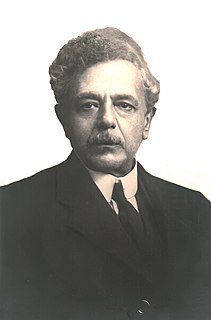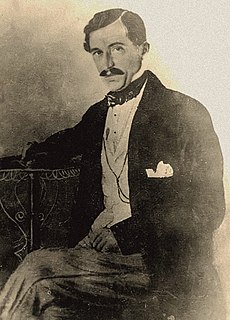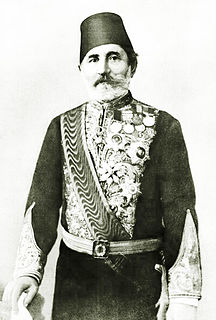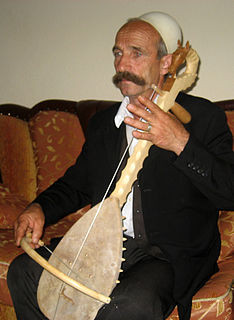Related Research Articles

The Brothers Grimm, Jacob (1785–1863) and Wilhelm (1786–1859), were German academics, philologists, cultural researchers, lexicographers, and authors who together collected and published folklore. They are among the best-known storytellers of folk tales, popularizing stories such as "Cinderella", "The Frog Prince", "Hansel and Gretel", "Little Red Riding Hood", "Rapunzel", "Rumpelstiltskin", "Sleeping Beauty", and "Snow White". Their first collection of folk tales, Children's and Household Tales, began publication in 1812.

The Miladinov brothers, Dimitar Miladinov (1810–1862) and Konstantin Miladinov (1830–1862), were Bulgarian poets, folklorists, and activists of the Bulgarian national movement in Ottoman Macedonia. They are best known for their collection of folk songs called Bulgarian Folk Songs, considered to be the greatest of their contributions to Bulgarian literature and the genesis of folklore studies during the Bulgarian National Revival. Their third brother Naum (1817-1897) helped compile this collection too. Konstantin Miladinov is also famous for his poem Taga za Yug which he wrote during his stay in Russia.
Albanian literature stretches back to the Middle Ages and comprises those literary texts and works written in Albanian. It may also refer to literature written by Albanians in Albania, Kosovo and the Albanian diaspora particularly in Italy. Albanian occupies an independent branch within the Indo-European family and does not have any other closely related language. The origin of Albanian is not entirely known, but it may be a successor of the ancient Illyrian language.
The Aarne–Thompson–Uther Index is a catalogue of folktale types used in folklore studies. The ATU Index is the product of a series of revisions and expansions by an international group of scholars: originally composed in German by Finnish folklorist Antti Aarne (1910), the index was translated into English, revised, and expanded by American folklorist Stith Thompson, and later further revised and expanded by German folklorist Hans-Jörg Uther (2004). The ATU Index, along with Thompson's Motif-Index of Folk-Literature (1932) is an essential tool for folklorists.

Giuseppe Schirò was an Arbëresh neo-classical poet, linguist, publicist and folklorist from Sicily. His literary work marked the transition from the Arbëresh language to modern Albanian literature in Italy. He was a major protagonist of the Rilindja, the Albanian cultural awakening or Albanian Renaissance, in Italy.

Girolamo de Rada was an Arbëreshë folklorist, journalist, lawyer, playwright, poet, rilindas and writer. He is regarded as one of the most influential Albanian writers of the 19th century who played an essential role in the Albanian Renaissance.

Albanian folk beliefs comprise the beliefs expressed in the customs, rituals, myths, legends and tales of the Albanian people. The elements of Albanian mythology are of Paleo-Balkan origin and almost all of them are pagan. Albanian folklore evolved over the centuries in a relatively isolated tribal culture and society. Albanian folk tales and legends have been orally transmitted down the generations and are still very much alive in the mountainous regions of Albania, Kosovo, western North Macedonia, south-eastern Montenegro, and southern Serbia, and among the Arbëreshë in Italy and the Arvanites in Greece.

Thimi (Euthimio) Mitko was an activist of the Albanian National Awakening and folklorist.
Anastas Avramidhi-Lakçe or Anastas Avram-Lakçe (1821–1890) was an Albanian businessman and benefactor. Avramidhi was born in Korçë, modern southern Albania, then part of the Ottoman Empire. When he was young he migrated to Bucharest, Romania, where he became a successful businessman.

Spiro Risto Dine (1846–1922) was an Albanian rilindas, writer and playwright. His most known work "Waves of the Sea" was at the time of its publication the longest book printed in Albanian.

Jani Vreto was an Albanian writer, printer, publisher and important figure of the Albanian National Awakening. He was responsible for setting up and overseeing the work of the first Albanian printing house in Bucharest in 1886.
The Song of Marko Boçari from Suli is an Albanian polyphonic song of the early 19th century, narrating the death of Markos Botsaris, a Souliot leader.
Anastas Byku was a 19th-century Albanian publisher and journalist. His publication of the Pelasgos newspaper in 1861 in both Albanian and Greek languages is considered to be one of the first publications of a periodical in Albanian. His endeavor was short-lived but he tried again in 1878 with another newspaper, Promytheus o Pelasgos, this time exclusively in the Greek language. Byku held that the Greeks and the Albanians were descendants of the Pelasgians and the Illyrians, and were one single people, although they were of different religious faiths; still according to him the Albanians should be inseparable from the Greek nation: this idea would eventually estrange him from the activists of the Albanian National Awakening.

Zef Jubani or Giuseppe Jubany in Italian was an Albanian folklorist and activist of the Albanian National Awakening. He is known for the publication of a Collection of Albanian Folk Songs and Rhapsodies in the Gheg Albanian dialect. Jubani advocated the creation of a unique alphabet of the Albanian language. For his political activities, which often were anti-clericalist, Jubani was denounced to the Holy See by the Jesuit missionaries of Shkodër.

O Moj Shqypni is a poem written by Vaso Pasha, a political figure, poet, novelist, and patriot known for his role during the Rilindja. It was written between 1878, an important year for the League of Prizren and 1880. The poet, a critique of religious and political factionalism as a barrier to national unity of Albanians called for them overcoming religious divisions through a united Albanianism. In 1910, the music director of the orchestra of Vlorë melodized the poem.

Albanian epic poetry is a form of epic poetry created by the Albanian people. It consists of a longstanding oral tradition still very much alive. A good number of Albanian rhapsodes can be found today in Kosovo and northern Albania, and some also in Montenegro. Northern Albanian epic poetry is performed singing to the accompaniment of the lahutë or çifteli. Within the Albanian epic poetry, Kângë Kreshnikësh constitute the most important heroic non-historical cycle, while the songs of Skanderbeg form the most important historical cycle.

Donat Kurti (1903–1983) was an Albanian Albanian franciscan friar, educator, scholar and folklorist. Donat Kurti was born in Shkodër, back then Ottoman Empire). He studied theology and philosophy at the Collegium Antonianum in Rome and was ordained as a Franciscan priest in 1927. After his return to Shkodra, he taught at the Illyrian college. Kurti was particularly interested in Albanian folklore and epic verse. With Bernardin Palaj, he published the best-known cycles of epic poetry in Kângë kreshnikësh dhe legenda , Tirana, 1937.
The Albanian community in Egypt began with government officials and military personnel appointed in Ottoman Egypt. A substantial community would grow up later by soldiers and mercenaries who settled in the second half of the 18th century and made a name for themselves in the Ottoman struggle to expel French troops in 1798–1801. Muhammad Ali, an Albanian, would later found the Khedivate of Egypt which lasted there until 1952. In the 19th and early 20th centuries, many other Albanians settled into Egypt for economical and political reasons. However, in later years the activities of the fedayeen, Muslim Brotherhood, as well as the greater Egyptian Revolution of 1952 resulted in the Albanian community in Egypt largely abandoning the country and emigrating to Western countries.

Loni Logori (1871–1929) was an Albanian-Egyptian entrepreneur, poet, and activist of the Albanian National Awakening.

Gjergj Pekmezi was an Albanian linguist, philosopher, folklorist and diplomat. In 1916, he became a member of the Literary Commission of Shkodër, which established the first standard form of the Albanian language.
References
- 1 2 3 Robert Elsie. A Biographical Dictionary of Albanian History. I.B.Tauris. p. 313.
- ↑ Veli Veliu (1982). Recherches albanologiques: Folklore et ethnologie. Instituti Albanologjik i Prishtinës.
- 1 2 Donald Haase (2008). The Greenwood Encyclopedia of Folktales and Fairy Tales: A-F. Greenwood Publishing Group. p. 24.
- 1 2 3 Skendi, Stavro (1967). The Albanian national awakening. Princeton: Princeton University Press. pp. 121–122.
- 1 2 3 4 5 6 7 8 Marcel Cornis-Pope; John Neubauer (2004). History of the Literary Cultures of East-Central Europe: Junctures and Disjunctures in the 19th and 20th Centuries . John Benjamins Publishing. p. 337.
- ↑ Stuart Edward Mann (1955). Albanian literature: an outline of prose, poetry, and drama. B. Quaritch. p. 45.